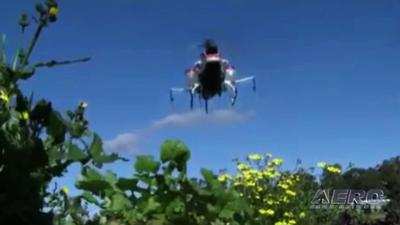Ag Sprayer UAS Has Been Operating Successfully In Several Other Countries
The FAA has granted an exemption that will allow Yamaha to begin commercial operation of its RMAX remotely piloted helicopter in the U.S. for precision agriculture purposes. The exemption was granted in accordance with Section 333 of the FAA Modernization and Reform Act of 2012, which provides civil operators like Yamaha a pathway to safe and legal entry into the U.S. National Airspace System (NAS).

The Yamaha RMAX has been the high performance standard in remotely piloted helicopters designed for agriculture spraying since its introduction in 1997. The RMAX platform has amassed well over 2 million total flight hours since its introduction. In Japan alone, there are over 2,400 RMAX helicopters utilized in agricultural applications, carrying out pest control in 35% of Japan's rice fields. The RMAX is also being used for commercial operations in South Korea, Thailand, Australia and New Zealand. Today’s approval from the FAA will enable Yamaha to begin offering these same valuable services in the United States.
“We appreciate the FAA’s efforts for approval of our Section 333 exemption and look forward to working closely with the FAA in the future," said Rob Trester, head of Corporate Planning at Yamaha. "With this approval, Yamaha is excited that we can now begin the first step of working with US customers and offer the performance advantages and cost savings that the RMAX provide.”
The RMAX is a big bird. According to the FAA's documentation, it is 9 feet long and 3 feet 6 inches tall, has an empty weight of 141 lbs. and a load capacity of about 61 pounds for both liquid and granular applications.
The main rotor is about 10 feet in diameter and extends 4 feet from either side of the RMAX and less than 3 feet from its front. The RMAX usually flies at a speed of no more than 12 mph (with a maximum speed of 45 mph). It is powered by a 2-cylinder, 246 cc engine that uses regular unleaded fuel with 2-stroke engine oil with a maximum output of 21 horsepower.
In petitioning the FAA for the waiver, Yamaha said the RMAX carries neither a pilot nor passenger and will operate within visual line of sight (VLOS) of a trained pilot and visual observer (spotter) only over uninhabited areas (e.g. fields, groves and orchards) and away from airports (i.e. three nautical miles or more) and populated areas.
At its convention being held in Atlanta this week, AUVSI praised the FAA's move. “This latest exemption continues to highlight the tremendous potential UAS have in agriculture, helping farmers to more safely, effectively and efficiently manage their crops and improve yields," Brian Wynne, president & CEO of the Association for Unmanned Vehicle Systems International (AUVSI), said in a statement. "Yamaha’s exemption represents the first time the agency has approved a UAS for crop-spraying and it is also the largest platform granted permission to operate in the U.S.
“For more than 20 years, Yamaha has been using the RMAX in Japan, Australia and South Korea. It has also been working with UC Davis to research the effectiveness of RMAX to spray vineyards in California. By granting this exemption, the FAA is taking an important step forward to helping more industries in the U.S. realize the benefits UAS technology has to offer.”
In August 2014, AUVSI submitted comments to the FAA in support of Yamaha’s request for a Section 333 exemption to test UAS operations in agriculture and urged the agency to consider other low-risk commercial applications. AUVSI wrote:
“The FAA should promptly grant this exemption request, look for ways to allow for more commercial use of very small UAS immediately, and get on with rulemaking.”
A report from AUVSI found that precision agriculture will make up 80 percent of the domestic UAS market, which is projected to create more than 100,000 jobs and $82 billion in economic impact in the first decade after FAA integration is complete. During the same period, the UAS industry could create more than 18,000 jobs and approximately $14.4 billion in economic impact in California alone.
 ANN's Daily Aero-Term (04.26.24): DETRESFA (Distress Phrase)
ANN's Daily Aero-Term (04.26.24): DETRESFA (Distress Phrase) ANN's Daily Aero-Linx (04.26.24)
ANN's Daily Aero-Linx (04.26.24) Airborne 04.22.24: Rotor X Worsens, Airport Fees 4 FNB?, USMC Drone Pilot
Airborne 04.22.24: Rotor X Worsens, Airport Fees 4 FNB?, USMC Drone Pilot Airborne 04.24.24: INTEGRAL E, Elixir USA, M700 RVSM
Airborne 04.24.24: INTEGRAL E, Elixir USA, M700 RVSM Airborne-NextGen 04.23.24: UAVOS UVH 170, magni650 Engine, World eVTOL Directory
Airborne-NextGen 04.23.24: UAVOS UVH 170, magni650 Engine, World eVTOL Directory



